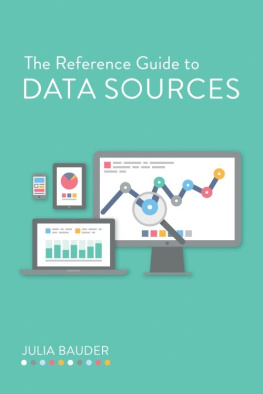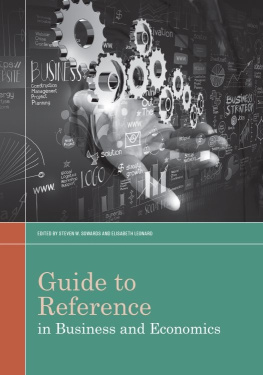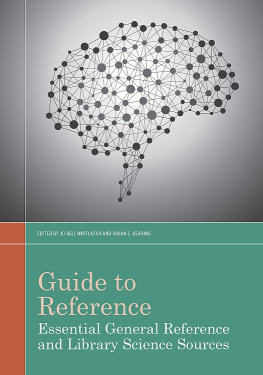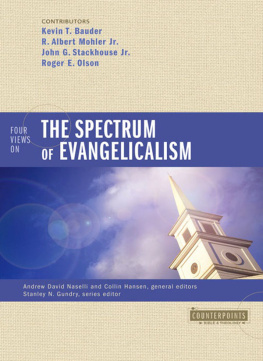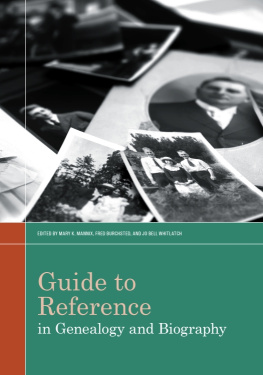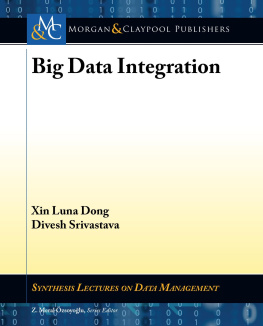Bauder - The reference guide to data sources
Here you can read online Bauder - The reference guide to data sources full text of the book (entire story) in english for free. Download pdf and epub, get meaning, cover and reviews about this ebook. City: Chicago;Illinois, year: 2014, publisher: American Library Association;ALA Editions, genre: Politics. Description of the work, (preface) as well as reviews are available. Best literature library LitArk.com created for fans of good reading and offers a wide selection of genres:
Romance novel
Science fiction
Adventure
Detective
Science
History
Home and family
Prose
Art
Politics
Computer
Non-fiction
Religion
Business
Children
Humor
Choose a favorite category and find really read worthwhile books. Enjoy immersion in the world of imagination, feel the emotions of the characters or learn something new for yourself, make an fascinating discovery.
The reference guide to data sources: summary, description and annotation
We offer to read an annotation, description, summary or preface (depends on what the author of the book "The reference guide to data sources" wrote himself). If you haven't found the necessary information about the book — write in the comments, we will try to find it.
Bauder: author's other books
Who wrote The reference guide to data sources? Find out the surname, the name of the author of the book and a list of all author's works by series.
The reference guide to data sources — read online for free the complete book (whole text) full work
Below is the text of the book, divided by pages. System saving the place of the last page read, allows you to conveniently read the book "The reference guide to data sources" online for free, without having to search again every time where you left off. Put a bookmark, and you can go to the page where you finished reading at any time.
Font size:
Interval:
Bookmark:
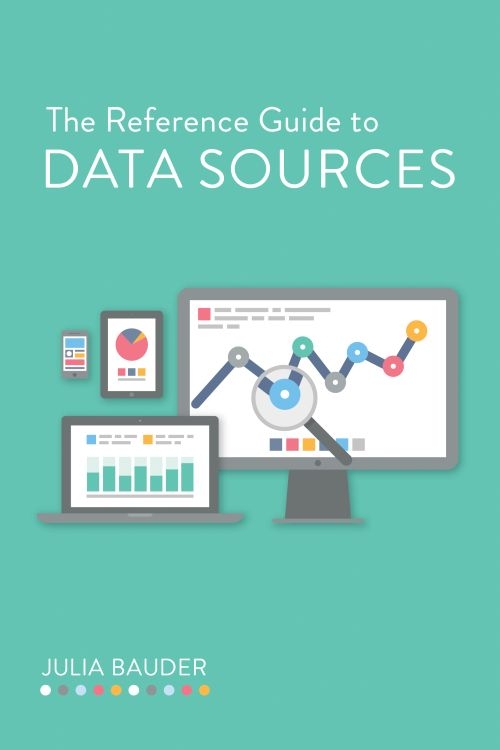
ALA Editions purchases fund advocacy, awareness, and accreditation programs for library professionals worldwide.
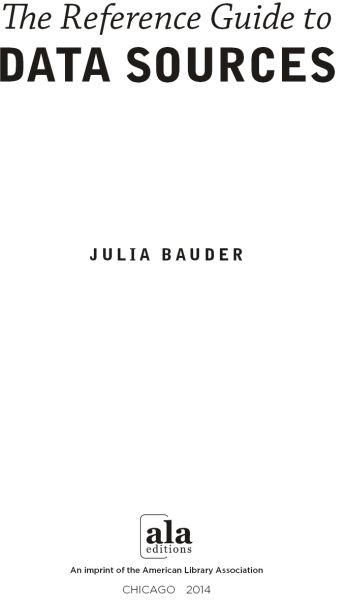
Julia Bauder is the social studies and data services librarian at the Grinnell College Libraries in Grinnell, Iowa. Bauder holds a masters degree from the School of Library and Information Science at Wayne State University in Detroit, Michigan. Before becoming a librarian, she spent several years as a freelance writer and editor of reference books.
2014 by the American Library Association
Extensive effort has gone into ensuring the reliability of the information in this book; however, the publisher makes no warranty, express or implied, with respect to the material contained herein.
ISBNs: 978-0-8389-1227-0 (paper); 978-0-8389-1962-0 (PDF); 978-0-8389-1963-7 (ePub); 978-0-8389-1964-4 (Kindle). For more information on digital formats, visit the ALA Store at alastore.ala.org and select eEditions.
Library of Congress Cataloging-in-Publication Data
Bauder, Julia.
The reference guide to data sources / Julia Bauder.
p. cm.
Includes bibliographical references and .
ISBN 978-0-8389-1227-0 (alk. paper)
1. StatisticsComputer network resourcesHandbooks, manuals, etc. 2. Social sciencesStatisticsHandbooks, manuals, etc. 3. Internet researchHandbooks, manuals, etc. 4. Electronic reference sourcesHandbooks, manuals, etc. 5. Internet searchingHandbooks, manuals, etc. 6. World Wide WebSubject accessHandbooks, manuals, etc. I. Title. II. Title: Guide to data sources.
HA33.5.B38 2014
025.06dc23 2014006175
Cover design by Alejandra Diaz. Image bloomva/Shutterstock, Inc.
Contents
Appendixes
T hank you to Anne ODwyer for introducing me to quantitative research in the social sciences, and to all of the faculty at Simons Rock College who worked so hard to help me become a better writer. I would not have been able to write this book without their patient teaching.
Thank you to Alana Joli Abbott for setting me up with my first freelance writing jobs, which started me on the career trajectory that led to this book.
Thank you to all of the data librarians who graciously welcomed me into the profession. This list includes Chuck Humphrey and Jim Jacobs, whose ICPSR class, Providing Social Science Data Services: Strategies for Design and Operation, was an excellent introduction to the field, and my colleagues in the International Association for Social Science Information Services and Technology and the ACRL Numeric and Geospatial Data Services in Academic Libraries Interest Group.
Thank you to the countless people over the years who have said to me, Hey, have you seen this great data set? I first became aware of many of the sources listed in this book because an enthusiastic colleague shared them with me, and I appreciate both the tips and the enthusiasm.
Thank you to Grinnell College for generously funding research leaves for junior faculty, including me, and to all of my colleagues in the Grinnell College Libraries who picked up the slack for me while I was off writing. I would never have had the time to write this book without that support.
Thank you to the wonderful editorial team at ALA Editions. They provided excellent suggestions that improved this book immensely.
And, finally, thank you to all of my friends and family who, for almost a year, put up with me saying, I cant; I have to write!
Q uestions about statisticsWhat is the population of London? How many people are diagnosed with cancer annually?have long been a staple at library reference desks. Most librarians are familiar with the print ready-reference sources that were traditionally kept within reach to answer themthe Statistical Abstract of the United States, The World Almanac and Book of Facts, and the CIA World Factbook, to name just a fewand, now, with the online equivalents of these publications. Not too many years ago, however, data reference was a specialized library service available primarily at research libraries. Few librarians outside of those institutions would ever encounter a question like I need thirty years of time-series data on the production of beef in Texas at the county level, and even fewer librarians would have been comfortable with the intricacies of working with data on reel-to-reel tapes and punchcards.
Two changesthe rise of the Internet, which has made disseminating data much less complicated, and the spread of statistical software packages into the undergraduate curriculumhave blurred the line between statistics reference and data reference. As more data and more user-friendly tools to work with data have become available, interest in finding and using quantitative data has grown. Yet data-related reference questions are often some of the most daunting questions for general reference librarians. My hope is that this guide makes those questions a little less daunting.
For Whom Is This Guide Intended?
Although I hope that all reference librarians find this guide helpful, its primary audience is librarians at public libraries, high school libraries, and the majority of academic libraries that do not employ staff dedicated to data reference. Librarians working with undergraduates at large research institutions may also find that the guide allows them to answer some basic data reference questions without having to refer students to a dedicated data services librarian.
Because the intended audience is primarily librarians at institutions that have not made a major financial commitment to data services, this guide focuses on freely available, online sources for data. In many subject areas, much of the most frequently used data can be found online for free if one knows where to look. On the occasions when a commonly requested type of data is not freely available from any online source, subscription databases or print series containing the data may be mentioned. Librarians whose institutions subscribe to many statistical databases may find Lynda M. Kellams guide Numeric Data Services and Sources for the General Reference Librarian (Chandos, 2011), which focuses more on subscription databases for data reference, to be helpful for their situation.
This guide focuses on data available through English-language interfaces, although it occasionally makes reference to data available in foreign-language interfaces. It does not include certain specialized scientific data sources, such as gene sequence databases or databases of chemical structures; nor does it include qualitative data sources. Instead, the focus is on quantitative social science data, broadly definedthat is, data that is primarily useful in the context of social science disciplines such as economics and sociology, as well as scientific data that frequently is or can be deployed in the context of government policy making, such as data on public health, climate change, or natural disasters.
In the following thematic , the discussion is divided into three categories: major sources for U.S. data, major sources for international data, and minor sources. The sites listed as major sources are large databases, typically from the major international or federal government agencies with responsibility for a given area; they are the most likely resources for answering most common reference questions in their areas.
Minor sources were selectively chosen from the dozens of smaller data sources in each area because they fill a gap in the data that is available from the major sources or because they present a selection of data from the major sources in a more user-friendly interface.
Next pageFont size:
Interval:
Bookmark:
Similar books «The reference guide to data sources»
Look at similar books to The reference guide to data sources. We have selected literature similar in name and meaning in the hope of providing readers with more options to find new, interesting, not yet read works.
Discussion, reviews of the book The reference guide to data sources and just readers' own opinions. Leave your comments, write what you think about the work, its meaning or the main characters. Specify what exactly you liked and what you didn't like, and why you think so.

